Thorns and Prickles and Spines, Oh My!
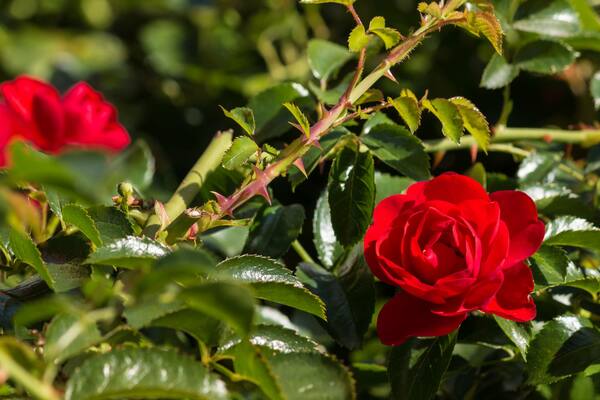
Exploring Thorn-Bearing Trees: Benefits and Management
Thorn-bearing plants and trees, while relatively uncommon, play a vital role in the ecosystem. Often, thorns are seen as problematic traits, and trees that bear them are often avoided during installations. Some organizations have even produced thornless cultivars to address the issue. Despite being viewed as problematic by some, thorns serve various purposes, from deterring predators to supporting climbing plants. Integrating thorn-bearing plants or trees into your landscape can enhance biodiversity and visual interest, providing a habitat for wildlife and adding unique textures. Thorns are not always bad; in some cases, they can even help you accomplish certain goals.
Choosing the right thorn-bearing trees involves considering factors like growth habit and maintenance requirements. Proper care and maintenance are crucial for ensuring the health of these trees, requiring proactive measures such as pruning and pest management.
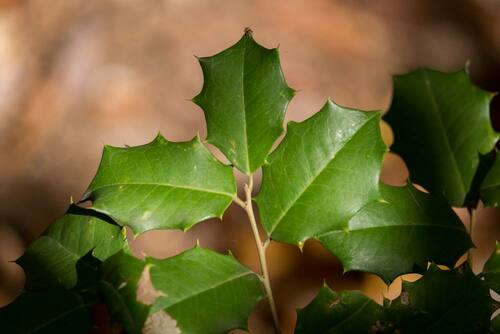
Spines on the Leaves of an American Holly plant
Technical Terms
Knowing the Difference
Many people use the terms thorn, spine and prickle interchangeably, but they do refer to three different plant features with unique characteristics.
Thorns are modified shoots, and are characteristic of hawthorns (Crataegus spp.), citrus trees (Citrus spp.) and honey locusts (Gleditsia triacanthos), among others. Spines are similar to thorns in that they feature internal vascular tissue, but they arise from leaf tissues, not shoots. Spines adorn a number of shrubs, including barberry (Berberis vulgaris) and some species of holly. Prickles are the most divergent of the tree types, as they only attach to the surface of the stem or trunk, and have no vascular tissues connecting them to the main body of the plant. Perhaps not surprisingly, prickles (as are found on roses) are easier to remove from a stem or branch than spines or thorns are.
When selecting trees for your landscape, consider the presence of thorns, spines, or prickles and their implications for maintenance and aesthetic appeal. Understanding these structures can guide your choices and ensure they align with your landscaping goals. Consulting with knowledgeable experts can provide valuable insights into selecting tree species suited to your specific needs and environmental conditions.
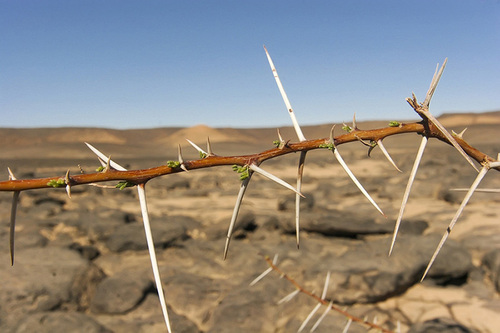
Large Thorns on a Narrow Branch
Primary Purpose
Self-Preservation
The primary reason trees developed thorns in the first place was to deter hungry herbivores. These mechanical deterrents are not the only strategy plants use for defense; others have evolved chemical defenses and produce urticating, noxious or toxic compounds. Nevertheless, thorns have stood the test of evolutionary time because, well, they do the job!
Thorns are not foolproof -- they fail to deter arthropods, for example – but they are effective enough that thorns are worth the resources they require, which could be used elsewhere. Most animals prefer an easy meal, so when they encounter a thorny tree, they usually move on. However, some animals have adaptations that allow them to bypass thorns. That's why in places with lots of hungry mouths to feed, like the African Savannah, thorns are abundant. Nevertheless, thick hides and long tongues help many animals avoid thorns and feed on the delicate foliage.
Adding thorn-bearing trees to your yard is a great idea. Not only are they resilient, but they also add visual interest. Plus, they can help keep unwanted visitors at bay. Taking advantage of thorny plants can give your yard a natural defense upgrade.
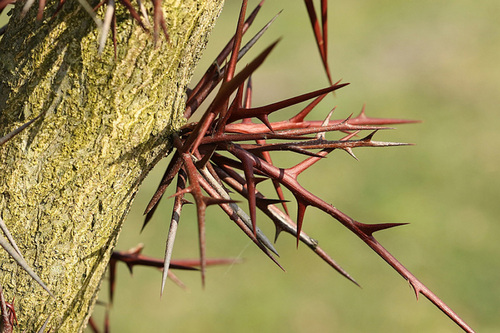
A Cluster of Reddish Thorns Protruding from a Branch
Serving Human Needs
Maximizing Security with Thorn-Bearing Trees
Strategically planting thorn-laden trees and shrubs can enhance security measures for your property. While the idea of intentionally incorporating spiked species may seem unconventional, it can be an effective deterrent against potential intruders. Many law enforcement agencies recommend using thorn-bearing trees or other noxious plants to discourage criminals from targeting homes and land. While these trees may not create an impenetrable barrier, their prickly defenses often provide enough resistance to deter the average opportunistic criminal, prompting them to seek easier targets elsewhere. Companies like PlantVine sell a wide variety of plants, making it easy to find the perfect thorny shrub to protect your property.
Wildlife Management: Balancing Deterrence and Habitat Enhancement
Thorny trees serve as valuable wildlife management tools, offering dual benefits in deterring unwanted species while attracting desirable wildlife. For instance, a hedge of hawthorns or honey locusts can dissuade local deer from encroaching on your property, minimizing potential damage to landscaping and crops. Additionally, dense thickets of blackberry bushes can prevent cats from lurking beneath bird feeders, preserving bird populations and their nesting sites. Furthermore, these thorny habitats may attract birds seeking refuge from predators, offering a safe haven for nesting and foraging. Remarkably, certain bird species, such as shrikes, utilize thorns and spines to impale their prey, demonstrating the intricate relationships between wildlife and thorny vegetation.
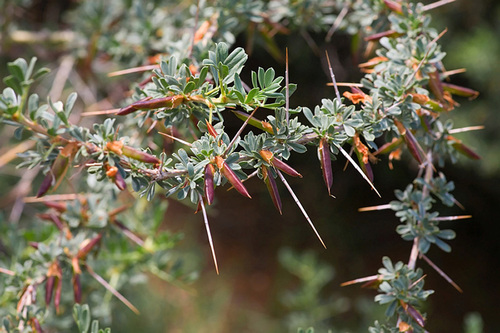
A Thorny Shrub Branch Lined with Small Green Leaves
Conclusion
Making Informed Choices for Your Landscape
Thorns, prickles, and spines play vital roles in the natural world, serving as nature's defense against herbivores and contributing to the intricate balance of ecosystems. Understanding the differences between these structures can empower homeowners and landscape enthusiasts to make informed choices when selecting trees and shrubs for their outdoor spaces. By harnessing the power of thorny vegetation, you can enhance your security measures, promote local biodiversity, and create resilient landscapes that thrive in the dynamic environments of the San Francisco Bay area.
Expert Guidance for Sustainable Landscaping
At Arborist Now, we understand the importance of balancing function and beauty in your landscape design. Our team of certified arborists specializes in providing expert guidance on tree selection, care, and maintenance tailored to the unique characteristics of the San Francisco Bay area. Whether you're seeking to incorporate thorn-bearing trees for added security or enhance habitat diversity with native vegetation, we're here to help. Contact us for a knowledgeable partner in creating sustainable, vibrant outdoor spaces that celebrate the diverse beauty of nature.
We may receive affiliate compensation for some of the links below at no cost to you if you decide to make a purchase.
Originally published on May 31, 2016.






